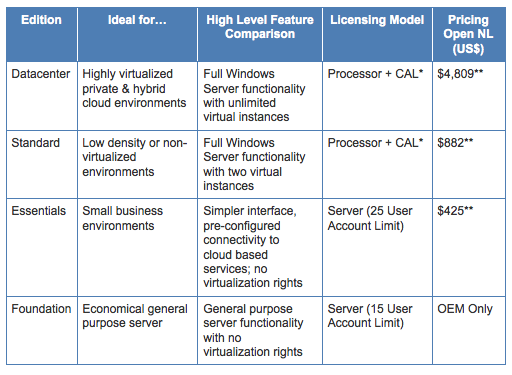 Image: Microsoft
Image: Microsoft Windows Server 2012 Emphasizes Microsoft Cloud Drift
Microsoft’s Windows Server 2012 offerings could benefit any organization just starting to dip a proverbial toe into the virtualization and cloud game. At the same time, however, it could alienate fans of Microsoft’s Windows Home Server and Windows Small Business Server, both of which have been eliminated from the Windows Server 2012 edition list. Killing Home Server might not seem that much of a stretch; after all, while most people seem perfectly willing to stock their household with all manner of desktops, laptops, tablets and smartphones, relatively few (outside of hardcore Windows fans and tech hobbyists) take the extra step of linking those devices to a common hub for sharing media and other data. Indeed, consumers are more likely these days to turn to cloud storage (such as SkyDrive or iCloud) for their data needs. Microsoft announced the killing in a FAQ subsequently reposted by bloggers such as All About Microsoft’s Mary Jo Foley. “Windows Home Server has seen its greatest success in small office/home office (SOHO) environments and among the technology enthusiast community,” read the relevant passage from that document. “For this reason, Microsoft is combining the features that were previously only found in Windows Home Server… into Windows Server 2012 Essentials.” Those features include support for DLNA-compliant devices and media streaming. Windows Server 2012 Essentials could also largely replace Small Business Server, which failed to make the official list of Windows Server 2012 editions. Small Business Server offered features such as a simplified setup for PCs on the network, improved dashboards for email and policy management, and a variety of remote access tools. As pointed out by several bloggers, however, these are all functions that can be served in a more streamlined way by cloud services. Indeed, of the four Windows Server 2012 editions, three of them focus considerably on virtualization and the cloud. The Datacenter edition is billed as ideal for “highly virtualized private & hybrid cloud environments,” while the Standard is meant for “Low density or non-virtualized environments.” Essentials, meanwhile, is targeted at small businesses, boasting features such as a streamlined interface and “pre-configured connectivity to cloud based services” (although no virtualization rights). The fourth option, Foundation, is a general-purpose platform with no virtualization rights. Microsoft has made no secret of its interest in the cloud as a “glue” of sorts for nearly its whole product portfolio. Indeed, CEO Steve Ballmer and other executives have repeatedly shouted (sometimes literally) that Microsoft is “all in” with regard to the cloud. Windows Server is obviously another product line being re-conceived within that context; and in the process, some of its components will end up set out to pasture. The Windows Server 2012 editions' licensing models and pricing are as follows:  Image: Microsoft
Image: Microsoft
 Image: Microsoft
Image: Microsoft